Available 24/7
Available 24/7
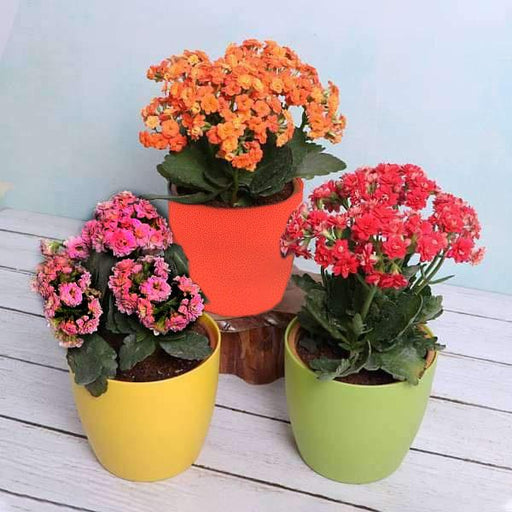
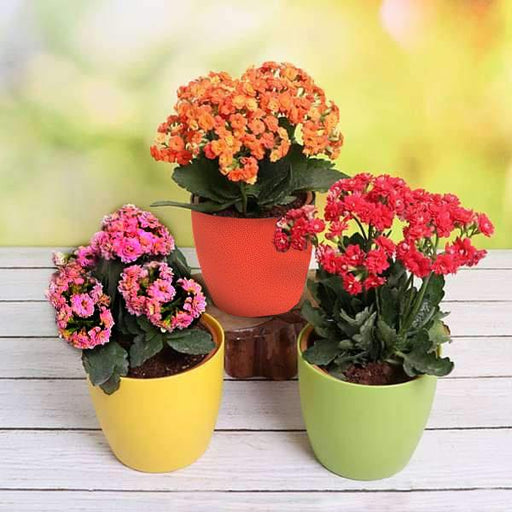 Save 10%
Save 10%
DescriptionThe Kalanchoes are thick leaved elegant flowering succulent houseplants. Make your home garden more vibrant and full of colors by bringi...
View full details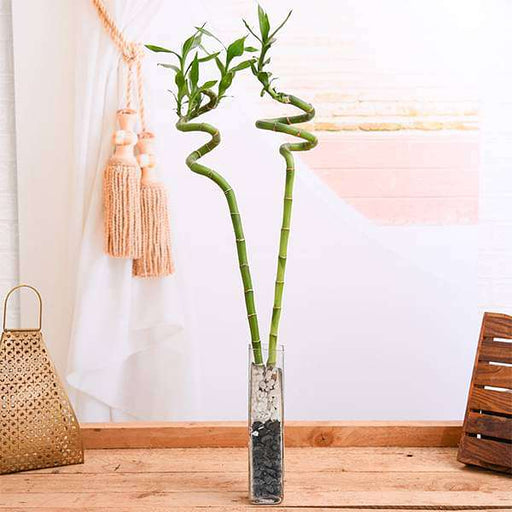 Save 18%
Save 18%
DescriptionThis pack contains two 60 cm Spiral Stick Lucky Bamboo Plant + Glass vase + 250g white chip pebbels + 250g black chip pebbels.About Luc...
View full details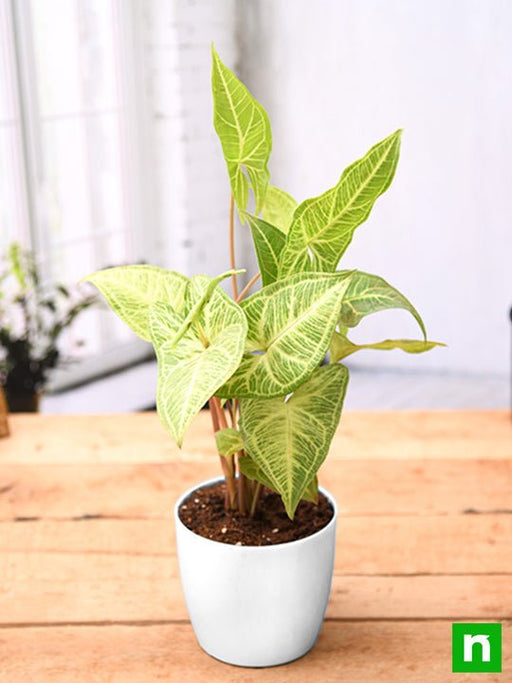

DescriptionIf the juvenile foliage along with a more compact plant is preferred, cut off all the climbing stems that develop, this will keep it bus...
View full details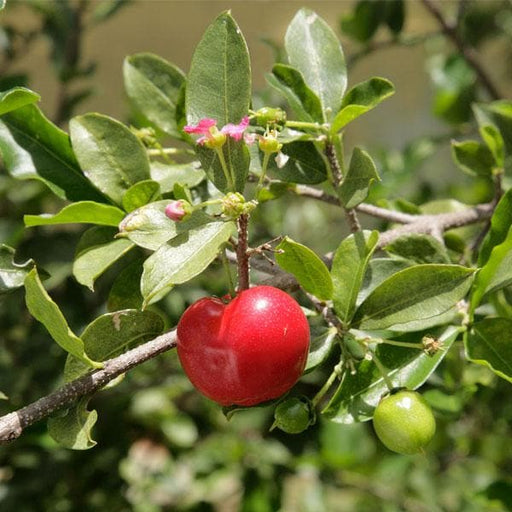 Save 15%
Save 15%
DescriptionGrowing Barbados Cherry is an easy way to add a tropical flair to your garden. When you know its important and how to care for Barbados ...
View full details Save 17%
Save 17%
DescriptionImprove immunity of your all family member by growing a nutritious and vitamin rich an amazing Amla plant. Amla is a small to the medium...
View full details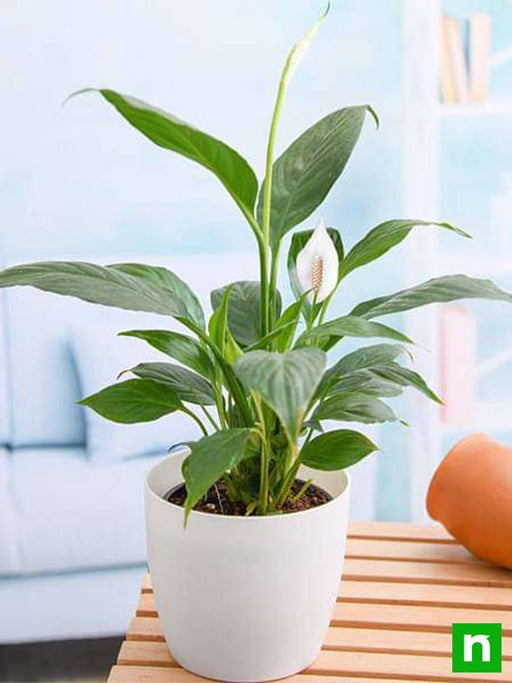
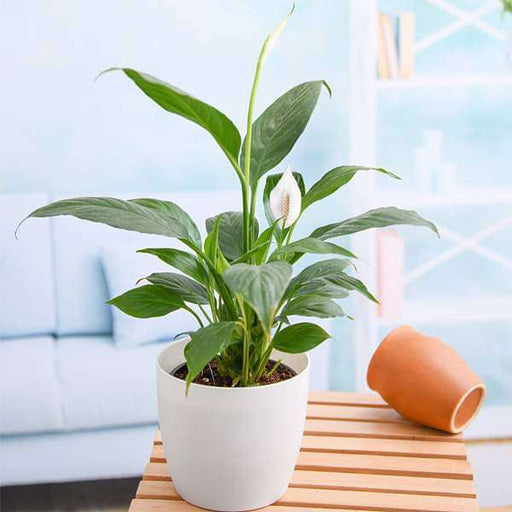 Save up to 15%
Save up to 15%
DescriptionPeace Lily Plant is a very popular and very rare indoor flowering houseplant. It is also an excellent air purifier plant.What makes it s...
View full details
 Save 20%
Save 20%
DescriptionFlowers make intimate connections they increase our connectivity with family and friends. Mogra plant is famously known as Jasmine flowe...
View full details
 Save 10%
Save 10%
DescriptionThe Kalanchoes are thick leaved elegant flowering succulent houseplants. Make your home garden more vibrant and full of colors by bringi...
View full details Save 45%
Save 45%
Description Pack of 4 succulents that are very easy to care for. A perfect pack to start growing plants worry-free. About You get 4 succulent plant...
View full details Save 12%
Save 12%
DescriptionAromatic plants bring into a room or house an often overlooked benefit. These plants have a pleasant scent.About You plant a hope when ...
View full details
 Save up to 50%
Save up to 50%
DescriptionIf you long for indoor greenery but have not succeeded with houseplants, consider these beautiful succulents. A perfect pack to start gr...
View full details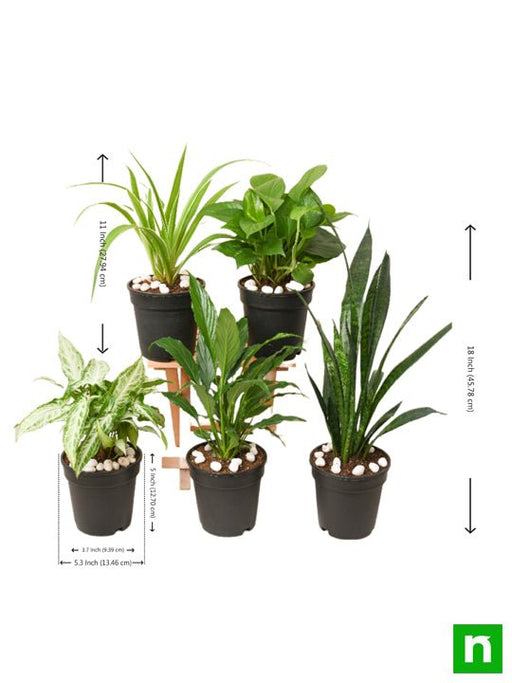
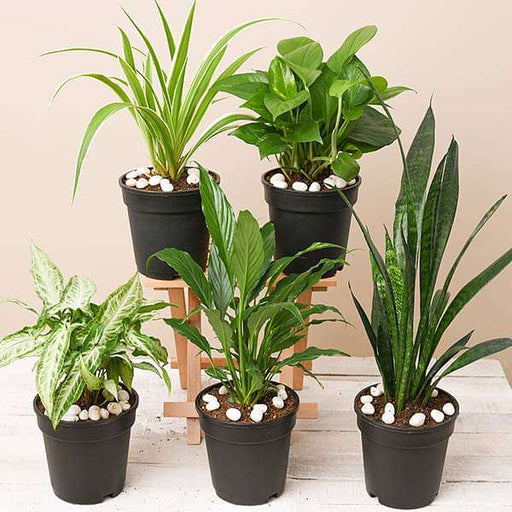 Save 21%
Save 21%
DescriptionThis plants pack contains amazing 5 houseplants + 5 Pots. Surround your home with these best pollution killer plants for a clean and hea...
View full details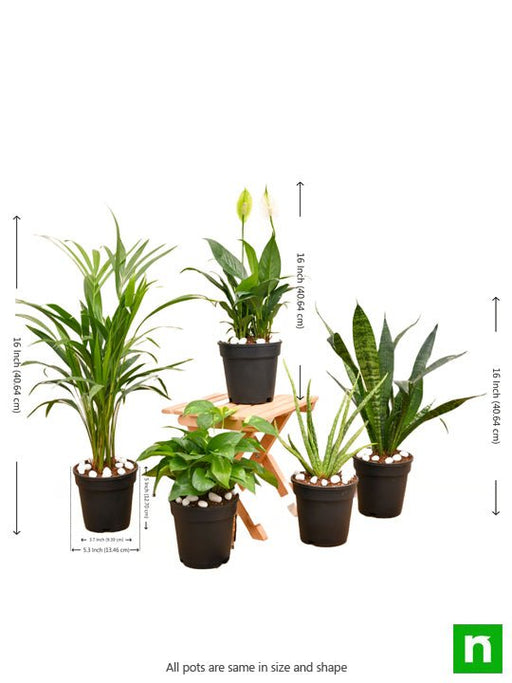
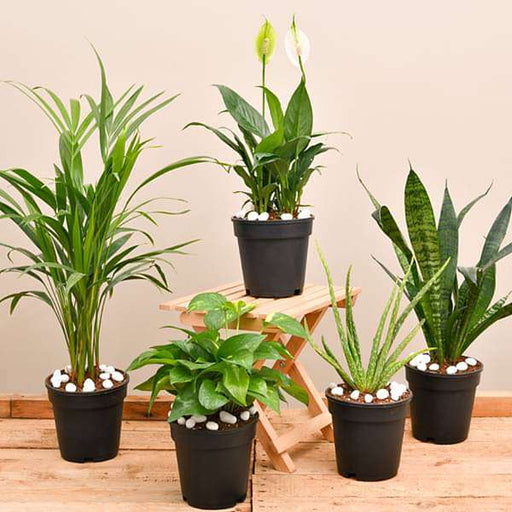 Save 20%
Save 20%
DescriptionIf you or anyone from your family wants to breathe fresh air, cleaner air in their homes, this 5 plants pack purify the air around and r...
View full details
 Save 40%
Save 40%
DescriptionSet of 2 Bonsai Looking Grafted Adenium PlantsAbout You get 2 Bonsai looking hardy grafted Adenium plants in a single pack.Plants are k...
View full detailsIndoor plants are more than just decorative additions to your home; they also offer a range of health benefits, from purifying the air to reducing stress levels.
People have become more and more conscious about the environment, and thus there is a sharp rise in green space. Since confined spaces are on the increase especially in urban cities, therefore a new trend that goes by the name of Indoor plants.
An indoor garden may be a haven from the outside world and a source of tremendous joy for many people. Introducing specific plants into your home, whether you live in a little apartment or a large house, will start to improve your health and overall pleasure.
indoor plants offer a range of benefits, from purifying the air to reducing stress levels. With so many varieties to choose from, there's sure to be an indoor plant that suits your style and care requirements.
So, whether you're a seasoned plant parent or just getting started, give one of these indoor plants a try and enjoy the benefits of a greener home.
By now, you must know that Indoor plants do not require much sunlight. So, you can keep them in indirect light places easily. Watering is another important tip for indoor plants and thus make sure that these plants are only watered when the topsoil is dry.
You can touch and find out if the topsoil is dry or not. Another important tip for the maintenance of Indoor Plants is to make sure you show them some light. And thus on weekends offer them a glimpse of the sun. Either take them to your terrace or balcony. Sunlight is also important for them, but it should be quite optimum.
Nursery Live has the biggest collection of indoor plants. You will find a huge variety of plants that are meant to stay indoors on this website. These are available in a variety of sizes and shapes. Get home these beauties at quite an affordable cost and decorate the green corner of your home.
The roots sit in excess water and gradually rot, taking away the plant's ability to absorb nutrients and moisture. In order to make it as easy as possible for you to keep your plant alive, it's always best to keep a plant in a pot that has drainage holes in the bottom.
These indoor plants including Snake Plant, Peace Lily (Spathiphyllum), Lucky bamboo plant, Chinese Evergreen (Aglaonema) & others are perfect for homes and offices with little or no natural sunlight. These plants thrive in low-light conditions and are also easy to grow.
Most people now are learning how to maximize their space and are taking their plants up and into the air by hanging them. Indoor hanging plants are really having a moment.
Apart from making your interiors inviting and luxurious, indoor plants are also acclaimed to make the indoor air healthier.
Some of the popular indoor plants for hanging includes spider plants, money plants, syngoniums, ferns, golden pothos, grape ivy and more.
Bringing plants indoors can provide a number of benefits including air purification , toxin removal and creating positive environment
As per the NASA list top air purifier includes Spider Plant, Money Plant, Peace Lily, Aglaonema, and bamboo palm amongst many others.
If you are looking for indoor plants with flowers to adorn your apartment, then Peace lily and Anthurium can be great picks.
Are you on a hunt for indoor plants for living room to make your living room look more aesthetic? Well, you are at right place.
Our indoor plant collection also has indoor plants to purify air around your apartment. These plants will help your lungs breathe better.
If you want to have some indoor plants for oxygen, then Peace lily, Snake Plants, Palm, Succulents are great choices.
The bigger the leaves or the higher number of leaves means more oxygen
We also have great options for indoor plants for bedroom that will amp up your decor game to manifold.
Some of the best indoor plants that clean indoor air and remove toxins from your bedroom includes English Ivy, Peace Lily, Weeping Fig, Spider Plant, Snake Plant, Golden Pothos, Dragon Tree, and Boston Fern
In any apratment, indoor plants decoration will make your apartment look breezy, calm and serene.
Indoor plants for office can help you become more productive at your work and can relieve your work related stress.
Indoor plants benefits are numerous and to avail these benefits you need to have green friends in your surroundings.
Looking to add some greenery to your urban jungle? Look no further than balcony hanging planters! These nifty little vessels are perfect for bringing a touch of nature to even the smallest of spaces. From vibrant violets to towering tomatoes, your balcony will be the envy of the neighborhood. So go ahead, hang loose and let those plants dangle!
Looking to spruce up your space with some leafy lovelies? Look no further than the best plants for home! From the low-maintenance snake plant to the trendy fiddle leaf fig, these green goddesses are sure to brighten up any room. So whether you're a seasoned green thumb or a budding beginner, get ready to transform your home into a veritable jungle!
Indoor plant decor is the ultimate way to bring the outdoors in. Whether you prefer leafy palms or succulent cacti, there's a plant for every personality. So ditch the bland wall art and go green!
Looking for a statement piece? Tall indoor plants like the snake plant and rubber tree add height and drama to any space.
From air-purifying spider plants to trendy monstera deliciosa, the types of indoor plants are endless. Choose the perfect plant for your home's vibe!
Brighten up your home with the colorful blooms of indoor flowering plants in India, like the peace lily or African violet.
Add a touch of the forest to your living room with indoor tree plants like the fiddle leaf fig or Norfolk Island pine.
The best indoor plants for health? Try the peace lily for cleaner air or the aloe vera plant for its soothing gel. Your home and body will thank you!
No window, no problem! These small indoor plants don't need sunlight to thrive. From the hardy snake plant to the whimsical air plant, they're perfect for any light-deprived nook or cranny.
Brighten up your workspace with small desk plants that don't need sunlight. The resilient ZZ plant and cute little succulents are perfect for adding a touch of green to your desk.
Bring the forest indoors with indoor tree plants that can handle low light conditions. The majestic bird's nest fern and tropical parlor palm are perfect for shady corners.
Important note: While indoor plants offer a range of benefits, some can be toxic to pets and children. Always research the toxicity of a plant before bringing it into your home, and keep it out of reach of curious pets and children.
Indoor plants are a great way to add color and life to your home or office. To care for your indoor plants, make sure they receive the right amount of sunlight and water, and keep an eye out for any signs of pests or disease.
There are countless types of indoor plants to choose from, each with its own unique characteristics and care requirements. Some popular indoor plant types include pothos, spider plants, and philodendrons.
Indoor plants are not just pretty to look at, they also offer a range of benefits for your health and wellbeing. They can help purify the air, reduce stress levels, and boost productivity.
Choosing the right location for your indoor plants is crucial for their health and wellbeing. Consider factors such as sunlight, humidity, and temperature when deciding where to place your plants.
Choosing the right pot for your indoor plants is important for their growth and development. Make sure the pot is the right size for your plant and has adequate drainage.
Indoor plants can be susceptible to pests such as spider mites, mealybugs, and aphids. Regularly inspect your plants for signs of infestation and treat promptly if necessary.
Indoor plants require different amounts of light depending on their species. Some plants thrive in low light conditions, while others require bright, indirect sunlight.
Indoor plants can benefit from added humidity, especially during dry winter months. Consider using a humidifier or misting your plants regularly to keep them healthy and happy.
Overwatering is a common mistake when it comes to indoor plant care. Make sure to water your plants when the soil feels dry to the touch, and avoid letting them sit in standing water.
Propagating indoor plants can be a fun and rewarding way to expand your collection. Methods of propagation include stem cuttings, leaf cuttings, and division.
Choosing the right soil for your indoor plants is important for their growth and development. Make sure the soil is well-draining and rich in nutrients.
Indoor plants come in a wide range of colors, from vibrant greens to shades of pink, red, and purple.
Indoor plants can range in size from small tabletop plants to large floor plants. Consider the size of your space and the amount of light available when choosing the size of your plants.
Indoor plants are not just a source of natural beauty, they can also be used to decorate your home or office. Consider using plants in creative ways, such as hanging them from the ceiling or using them as a centerpiece.
Accessories such as plant stands and decorative pots can help elevate the look of your indoor plants and make them a focal point of any room.
Some indoor plants can be toxic to pets and humans if ingested. Make sure to research any plants you bring into your home and keep them out of reach of children and pets.
Many indoor plants are known for their air-purifying abilities, helping to remove pollutants and toxins from the air in your home or office.
In addition to their physical benefits, indoor plants can also offer mental health benefits. They can help reduce stress levels and improve mood and concentration.
Regular maintenance is key to keeping your indoor plants healthy and happy. This includes watering and fertilizing on a regular schedule, pruning as needed, and inspecting for pests or disease.
Indoor plant trends are constantly changing, with new varieties and styles becoming popular all the time. Some current trends include hanging plants, terrariums, and plant arrangements in unusual containers such as teacups or wine bottles.
There are many indoor plants that are easy to care for and perfect for beginners, including the spider plant, pothos, snake plant, and ZZ plant. These plants are low-maintenance and can survive in a range of lighting conditions.
The watering requirements of indoor plants vary depending on the plant species, soil type, and lighting conditions. In general, most indoor plants prefer to be watered once a week, but it's essential to check the soil's moisture level before watering.
Indoor plants thrive in well-draining soil that allows for proper air circulation and water retention. Choose a potting mix that contains perlite, vermiculite, or sand for added drainage and aeration.
Tap water may contain harmful chemicals like chlorine and fluoride that can harm indoor plants. It's best to use filtered or distilled water for indoor plants or let the tap water sit for at least 24 hours before watering.
If your indoor plant's roots start to grow out of the drainage holes, the plant may need to be repotted into a larger container. Additionally, if the soil becomes compacted and water is not being absorbed, it's time to repot.
During the winter months, indoor plants may require less watering and fertilizer due to decreased growth rates. Keep the plants away from cold drafts and heaters and ensure they receive sufficient sunlight.
Indoor plants require regular fertilization to thrive. Choose a balanced fertilizer that contains equal amounts of nitrogen, phosphorus, and potassium and follow the manufacturer's instructions for application.
Pests like spider mites and mealybugs can damage indoor plants. To prevent infestations, keep your plants clean and free from debris. If you notice signs of pests, treat them with a natural insecticide or neem oil.
Many indoor plants can be propagated through stem cuttings or division. Choose healthy plant material and follow the specific propagation instructions for each plant species.
Yes, indoor plants can improve air quality by absorbing harmful toxins and releasing oxygen. NASA research has shown that some indoor plants like the spider plant and snake plant can remove toxins like benzene, formaldehyde, and trichloroethylene from the air.
Consider the lighting conditions, temperature, and humidity levels in your space when choosing an indoor plant. Choose plants that thrive in the specific conditions of your environment.
Overwatering can lead to root rot and other issues in indoor plants. Use a moisture meter or check the soil's moisture level by sticking your finger in the soil. Only water when the soil is dry to the touch.
A terrarium is a mini-ecosystem for indoor plants. Choose a container and plants that thrive in humid environments, like ferns and mosses. Use a well-draining soil and add decorative elements like rocks and shells.
Dust and debris can accumulate on the leaves of indoor plants, hindering photosynthesis and growth. To clean the leaves, use a damp cloth or sponge to wipe away debris gently. You can also use a mild soap solution to remove stubborn stains.
Leggy indoor plants occur when the plant is not receiving enough light. To prevent leggy growth, place your plants near a window that receives bright, indirect sunlight or supplement with artificial grow lights.
Yes, many herbs can be grown indoors, including basil, parsley, thyme, and mint. Choose a sunny location and ensure that the soil remains moist but well-draining.
Indoor plants can attract bugs, especially if the plants are not properly maintained. Regularly inspect your plants for signs of infestation and take appropriate measures to prevent or treat pest problems.
If your indoor plant is not receiving enough light, it may start to droop, develop yellowing leaves, or stop growing. Place your plants near a window that receives bright, indirect sunlight, or supplement with artificial grow lights.
Root rot occurs when the soil remains too wet, leading to fungal growth and root damage. To prevent root rot, ensure that your indoor plants are potted in well-draining soil and that excess water is drained from the container.
Choose a pot that is slightly larger than the plant's current container and that provides adequate drainage. Consider the material, shape, and color of the pot to complement your indoor plant's aesthetic.
Indoor plants can become too dry if they are not watered frequently enough. Use a moisture meter or check the soil's moisture level regularly and water when the soil is dry to the touch.
Yes, many indoor plants can survive in low-light conditions, including the snake plant and ZZ plant. However, they may not grow as quickly or produce as many leaves as plants that receive brighter light.
Pruning is an essential part of maintaining indoor plants' health and shape. Use clean, sharp scissors or pruning shears to remove dead or yellowing leaves, stems, or flowers.
Choose a balanced fertilizer that contains equal amounts of nitrogen, phosphorus, and potassium for most indoor plants. However, some plants may require specialized fertilizers based on their specific nutrient needs.
During the winter months, indoor plants may require less water and fertilizer due to decreased growth rates. Ensure that they are placed away from cold drafts and heaters and receive sufficient sunlight.
If your indoor plant's roots are growing out of the container's drainage holes, or the soil is compacted and water is not being absorbed, it may be root-bound and require repotting.
Yes, many vegetables can be grown indoors, including tomatoes, peppers, and leafy greens. Choose a sunny location and ensure that the soil remains moist but well-draining.
Mold can develop on indoor plants if the soil remains too wet or if the environment is too humid. Ensure that your plants are potted in well-draining soil and that excess water is drained from the container. Additionally, maintain proper humidity levels in your space.
Choose a pot that is slightly larger than the plant's current container and provides adequate drainage. Avoid choosing a pot that is too large, as excess soil can lead to water retention and root rot.
During periods of dormancy, indoor plants may appear to be dead, with drooping or yellowing leaves. However, if the plant's stem and roots are still firm, it may simply be resting. If the stem and roots are mushy or blackened, the plant may be dead.
Yes, indoor plants can be grown in soilless mediums like coco coir, peat moss, or hydroponics.
Gnats can be attracted to indoor plants if the soil is too wet or if the environment is too humid. Ensure that your plants are potted in well-draining soil and that excess water is drained from the container. Additionally, maintain proper humidity levels in your space.
If your indoor plant's roots start to grow out of the drainage holes or if the soil becomes compacted and water is not being absorbed, it's time to repot into a larger container.
Indoor plants can become too tall if they are not receiving enough light or if they are not pruned regularly. Place your plants near a window that receives bright, indirect sunlight, and prune them regularly to maintain their shape.
Yes, indoor plants have been shown to reduce stress levels and improve mood by providing a calming and relaxing environment.
During hot weather, indoor plants may require more frequent watering and a humidifier to maintain proper moisture levels. Ensure that your plants are placed away from direct sunlight and that the soil remains moist but well-draining.
Yes, indoor plants can be grown in low-maintenance setups like terrariums or closed environments. Choose plants that thrive in humid environments, like ferns and mosses, and ensure that the soil remains moist but well-draining.
Many indoor plants can be propagated through water propagation, where the plant's stem is placed in water until roots begin to grow. Follow specific propagation instructions for each plant species.
If your indoor plant's leaves start to droop or turn brown, it may not be receiving enough humidity. Increase humidity levels by misting the plant regularly, using a humidifier, or grouping plants together.
Indoor plants can become too bushy if they are not pruned regularly. Use clean, sharp scissors or pruning shears to remove dead or yellowing leaves, stems, or flowers, and maintain the plant's shape by removing excess growth.
Indoor plants like aloe vera, snake plant, spider plant, and peace lily are known for their air-purifying properties and can help remove harmful toxins from the air.
Indoor plants like snake plant, aloe vera, and peace lily release oxygen at night and can help improve indoor air quality while you sleep.
Indoor plants like citronella, basil, and lemongrass are natural mosquito repellents and can help keep these pests away from your home.
Indoor plants like snake plant, ZZ plant, and pothos can thrive in low-light conditions and do not require direct sunlight.
Indoor plants like peace lily, snake plant, and aloe vera are known for their air-purifying properties and can help improve indoor air quality by producing more oxygen.
Indoor plants like money plant, jade plant, and lucky bamboo are believed to bring good luck and prosperity to the home.
Indoor plants can turn yellow due to a variety of reasons, including overwatering, underwatering, lack of nutrients, or pest infestations.
Indoor plants can turn yellow at any time, depending on the specific plant species and its environmental conditions.
Indoor plants require regular fertilization during their growing season, which is typically from spring to fall. Follow the manufacturer's instructions for application.
Indoor plants should be repotted when the roots start to grow out of the drainage holes or when the soil becomes compacted and water is not being absorbed.
Indoor plants should be watered when the soil is dry to the touch. The frequency of watering depends on the specific plant species and environmental conditions.
Indoor plants can be purchased at any time of the year. However, the best time to buy indoor plants is typically during the spring and summer months when there is more variety available.
Indoor plants require adequate lighting to thrive, but they do not necessarily need to be placed by a window. Supplemental grow lights can be used to provide additional light for plants that are not receiving sufficient natural light.
Indoor plants can be purchased at garden centers, nurseries, and online plant stores like Nurserylive.